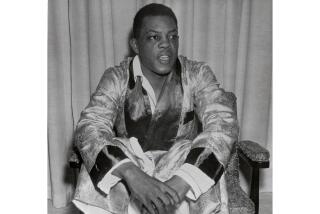Faye Dancer, 77; West L.A. Native Starred in Pro Baseball League
Faye Dancer, who was known as “All the Way Faye” during her heyday in the 1940s as one of the greats of the All American Girls Professional Baseball League, has died. She was 77.
Dancer, the inspiration for Madonna’s “All the Way Mae” character in the 1992 comedy film “A League of Their Own,” died May 22 after undergoing surgery for cancer at UCLA Medical Center.
For the record:
12:00 a.m. June 7, 2002 For The Record
Los Angeles Times Friday June 07, 2002 Home Edition Main News Part A Page 2 National Desk 5 inches; 200 words Type of Material: Correction
Dancer obituary--The obituary Saturday for Faye Dancer, an All American Girls Professional Baseball League player, misspelled the name of the Los Angeles field where Dancer played softball in the early 1940s. League games were played at Fiedler Field, which was south of 3rd Street on Fairfax Avenue
For six seasons, between 1944 and 1950, the West Los Angeles native played center field and occasionally pitched for the Minneapolis Millerettes, the Fort Wayne Daisies and the Peoria Redwings.
“She was a great all-around ballplayer,” said Lavonne “Pepper” Paire Davis, Dancer’s former teammate and lifelong friend.
Labeled a “fly-catching genius” by sportswriters of the day, Dancer “could go back on the dead run, catch the ball over her shoulder, wheel around and in one motion throw a strike to the catcher in the air from deep center field,” said Davis.
Dancer also was known for her hitting and base stealing. In 1948, she stole 108 bases.
“She was that rare breed of ball player that could get up to bat, lay down a perfect bunt, then steal second base,” said Davis. “Then, the next time up, she could hit the long ball and knock it out of the ballpark. She led the league in both categories at times, in stolen bases and home runs.”
Davis, who served as technical advisor on “A League of Their Own” and was a model for Geena Davis’ catcher character, said the Dancer-inspired character played by Madonna “dwelt a little bit more on the promiscuous side on sexual encounters. Faye had her share of admirers, but her [All the Way Faye] nickname really came from her all-out-style of play. On the ball field, there wasn’t anything she wouldn’t do to win.”
She would crash into the fence to make a catch; she’d dive head first into a base; and if a bunt was needed, she’d lay down a bunt, Davis said.
“In the All American Girls League we had to wear skirts and look like ladies at all times,” Dancer once said. “The guys would look at our short skirts, then look at our legs and wonder how we could slide without taking all the hide off ourselves. Well, we did take the hide off ourselves.
“I loved to slide.”
Dancer’s all-out playing style was memorably captured in a 1948 photograph that shows her sliding into third base to avoid being tagged by Marge Wenzell.
A large blow-up of the picture is prominently featured in the All American Girls Baseball League exhibit at the National Baseball Hall of Fame and Museum in Cooperstown, N.Y., which includes Dancer’s spikes and gloves.
Dancer joined Davis and more than 75 other former league members for the opening of the exhibit on Nov. 5, 1988.
The daughter of a Department of Water and Power inspector, Dancer was born in Santa Monica in 1925 and grew up in West Los Angeles. She discovered softball in grade school, but threw the ball so hard she typically had to play on the boys’ teams.
When she was 11, Dancer began playing in a local merchant-sponsored softball league, which played at the Veterans Administration ballpark off Wilshire Boulevard.
Always a fierce competitor, she worked hard to improve her game.
“I used to practice my slides in the sand at Santa Monica beach, then go home and lie on my bed and visualize my swings while I stared up at my bedroom ceiling,” Dancer told the Sacramento Bee two years ago.
From 1940 to 1942, Dancer and Davis were members of the Dr Peppers, a Class A amateur girls softball team sponsored by the soft drink company that played in league games at Fielder Field at Fairfax Avenue and 3rd Street.
In 1943, with many major league baseball players serving in the military, chewing gum magnate and Chicago Cubs owner P.K. Wrigley and others formed the All American Girls Professional Baseball League.
Wrigley had been informed by President Roosevelt that the 1943 major league baseball season might be suspended due to the number of players serving in the military.
Wrigley viewed the creation of the first professional baseball league for women as a way to preserve the national pastime during the war by entertaining fans with what was promoted as “Girls Baseball.”
In 1944, 18-year-old Dancer and Davis were among six California women ballplayers chosen by the league’s West Coast scout to report to league spring training in Peru, Ill.
Dancer earned a beginning salary of $75 a week, plus $2.50 a day for meals.
For three consecutive seasons in the late 1940s, more than 1 million fans paid $1.50 admission to watch the women play.
Dancer and her fellow players plied the Midwest on a rickety bus, routinely playing 10 games a week.
For the women, it was bad enough having to live down being called the Fort Wayne Daisies or the Racine Belles, but they also had to contend with wearing short-skirted uniforms that ranged in hue from bubble-gum pink to lemon yellow.
But the women, who played 110 to 130 ball games in four months, were as aggressive and tough as any male player.
To preserve what Wrigley called the “feminine angle” on and off the field, the players were required to attend a Helena Rubenstein charm school in the evenings during spring training.
League rules forbade them to appear in public in shorts, slacks and jeans, or with curlers in their hair. They couldn’t smoke, drink or curse in public. And on the field, they were not allowed to scream or kick dirt on the umpires.
As Davis recalled, “You had to walk and talk and act like a lady at all times, but play baseball like a guy.”
Dancer may have played baseball like a guy, but she put her own spin on the proceedings, earning a reputation as the “rebel of the league.”
“I was forever having fun, raising my skirt up for the fans, doing the splits and handstands when the games got quiet,” she recalled in 1992.
She was just as fun-loving off the field.
Each team had a chaperon and Dancer took it upon herself to initiate them: She’d put Limburger cheese on the light bulbs in their rooms, replace the icing in their Oreo cookies with toothpaste and smear peanut butter on their toilet seats.
“Some of them just couldn’t take it,” Dancer recalled.
Despite a 10 p.m. curfew, she and Davis were known to cut loose at night by sneaking out for beers. They’d avoid the coaches and chaperons in the hotel lobby by returning to their rooms via the fire escape.
Dancer once recalled that when she was playing for Peoria in 1947, two gangsters would come by to watch . They’d arrive in a blue Packard with bulletproof glass.
“The kingpin liked me,” she said. “He offered to buy my folks a new car. He offered me a golden palomino and said he’d put me up in the sporting goods business. Once, he even asked me if I wanted anyone killed. I told him, ‘Maybe the umpire.’”
Dancer retired from professional baseball in 1950 after severely injuring her back while sliding into a base.
After leaving the league, which was disbanded in 1954, she returned to her off-season job as an electronics technician for Hughes Aircraft. She then worked for 35 years as an electronics technician for a power generator manufacturing company in Santa Monica, where she lived.
In 2000, not long after being laid off from her job, she was diagnosed with breast cancer.
“She was a tough lady,” said Davis. “She fought every step of the way to win [in baseball] and she went out that way, fighting every step of the way.”
Dancer never married. “The love of her life was killed in the war,” said Davis.
She is survived by her brother, Richard Dancer, of Westchester.
A graveside service will be held at 11 a.m. Tuesday at Woodlawn Cemetery, 1847 14th St., Santa Monica.
More to Read
Go beyond the scoreboard
Get the latest on L.A.'s teams in the daily Sports Report newsletter.
You may occasionally receive promotional content from the Los Angeles Times.










